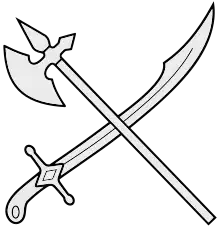
An edged weapon,[1] or bladed weapon, is a melee weapon with a cutting edge.[2] Bladed weapons include swords, daggers, knives, and bayonets. Edged weapons are used to cut, hack, or slash; some edged weapons (such as many kinds of swords) may also permit thrusting and stabbing. Edged weapons contrast with blunt weapons such as maces, and with thrusting weapons such as spears.
Many edged agricultural tools such as machetes, hatchets, pitchforks, axes, sickles, sling blades, and scythes, have been used as improvised weapons by peasantry, militia, or irregular forces – particularly as an expedient for defence.
Edged weapons and blades, as well as other cold weapons, are associated with the premodern age but continue to be used in modern armies. Combat knives and knife bayonets are used for close combat or stealth operations and are issued as a secondary or sidearm.[3] Modern bayonets are often intended to be used in a dual role as both a combat knife and knife bayonet.[4] Improvised edged weapons were extensively used in trench warfare of the First World War; for example, an entrenching tool might be modified to take an edge and be used as a melee weapon.[5][6]
See also
References
- ↑ Francis Andrew March (1902). A Thesaurus Dictionary of the English Language. London: Historical Publishing Company.
Blade: The flat, cutting part of an edged weapon.
- ↑ The Macquarie Dictionary (1st ed.). Sydney: Macquarie Library. 1981.
An edge tool is defined as a tool with a cutting edge. A blade is the flat cutting part of a sword, knife, etc. It is also a synonym for a sword.
- ↑ Peterson, Harold L., Daggers and Fighting Knives of the Western World, Courier Dover Publications, ISBN 0-486-41743-3, ISBN 978-0-486-41743-1 (2001), p. 80: "Right at the outset trench knives were introduced by both sides during World War I, so that the common soldier was once again equipped with a knife designed primarily for combat."
- ↑ Brayley, Martin, Bayonets: An Illustrated History, Iola, WI: Krause Publications, ISBN 0-87349-870-4, ISBN 978-0-87349-870-8 (2004), pp. 9-10, 83-85
- ↑ Beith, Ian H. (Capt.), Modern Battle Tactics: Address Delivered April 9, 1917, National Service (June 1917), pp. 325, 328
- ↑ Ian Drury (1995). German Stormtrooper 1914–18. Osprey Publishing. p. 61. ISBN 978-1-85532-372-8.